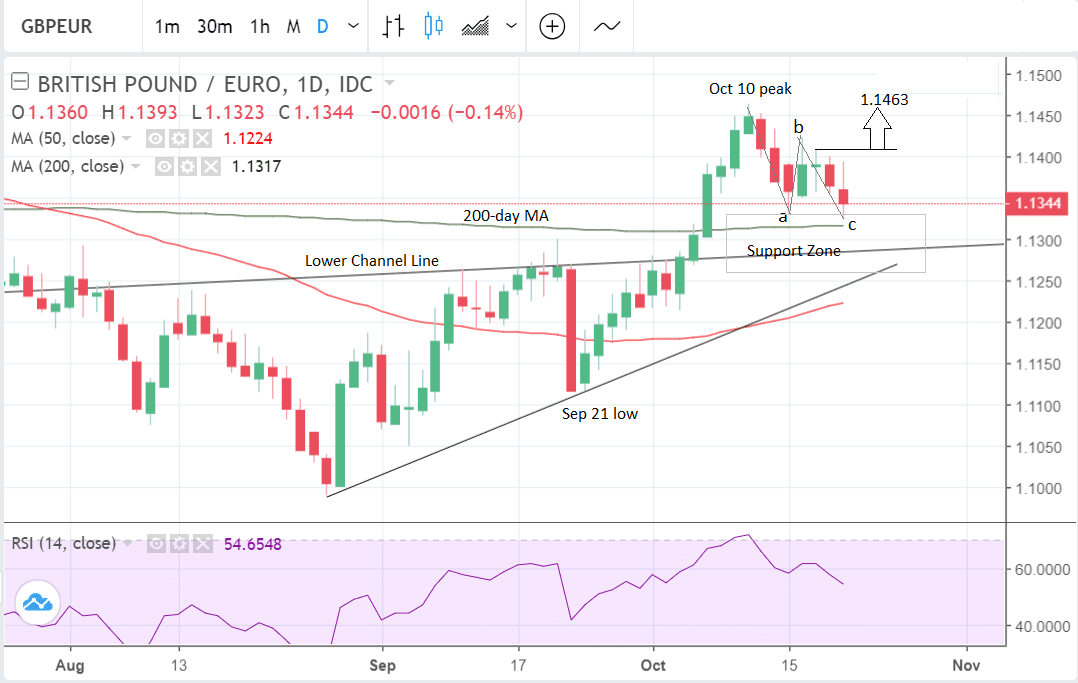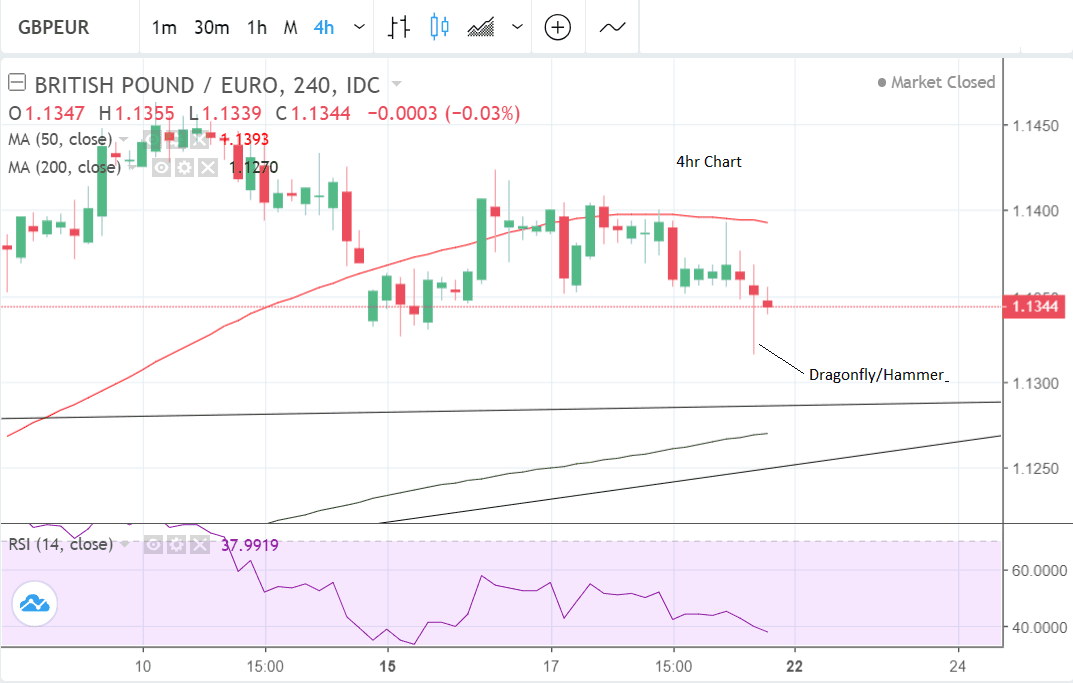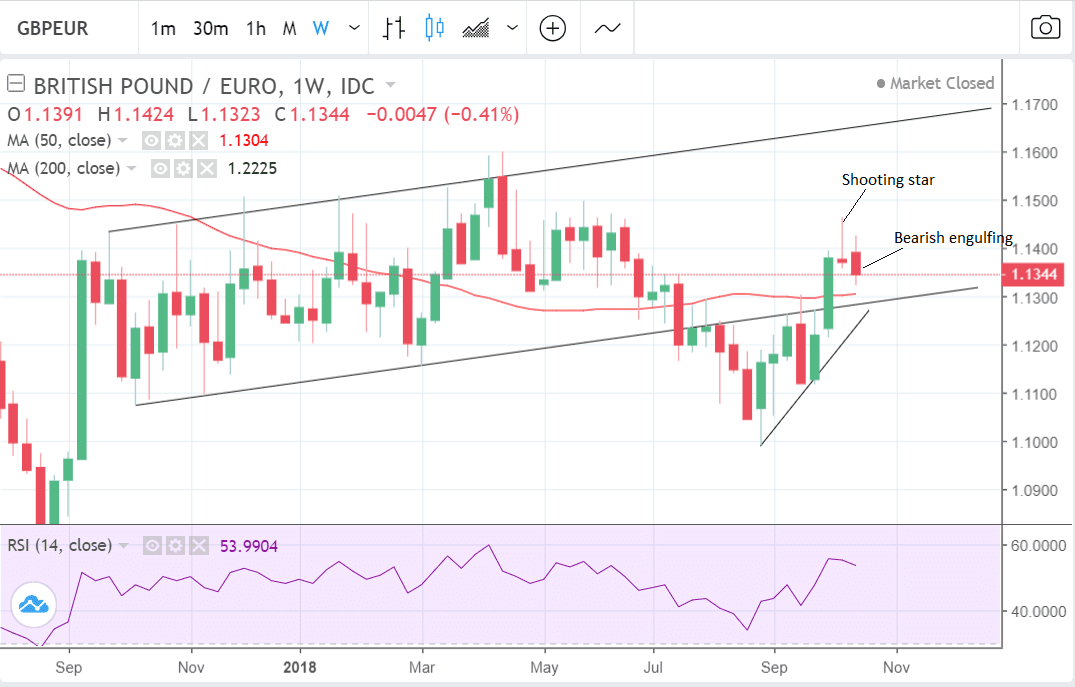The Pound-to-Euro Exchange Rate Week Ahead Forecast: Signs Uptrend May Resume After Correction

Above: The ECB policy decision could move GBP/EUR this week. Image © European Central Bank.
- GBP/EUR pull-back now looks complete
- Euro eyes ECB meeting + Italian budget saga
- But political uncertainty could hurt GBP
- Times reports P.M. May faces imminent leadership challenge
The British Pound's strong rally against the Euro during September and October could resume, suggest our latest technical studies.
The move multi-week move higher was extremely bullish before it suffered a pull-back last week, but we see a strong chance it will start up again in the week ahead if there are no political surprises to sour the charts.
The prior uptrend took the exchange rate from the 1.1118 September 21 low to the 1.1463 October 10 high - the pair's pull-back looks near complete and bulls could try to take control.
After peaking at the October 10 high the pair has been declining in what looks like a three-wave correction, of the 'abc' variety. This correction now looks complete and this heightens our expectations the trend will reverse and start moving higher again.
Another reason why we think there will be a rebound is the position of the 200-day moving average (MA) at the 1.1317 level only a few points below last week's 1.1323 lows. The MA presents a tough technical obstacle which bears will have difficulty breaking below.
Even if they do, there is further support not far below from the lower channel line of the long-term ascending channel, which is likely to present another hard floor for the pair. In this circumstance we see the path of least resistance as 'higher' and therefore see a rebound as the more likely next move.
Yet there is scant evidence of a reversal higher so far, with the only sign a bullish 'dragon-fly doji' (or possibly a hammer) Japanese candlestick pattern on the 4-hr chart.
We expect the pair will probably extend to retouch the October 10 highs. For conservative traders, a break above the 1.1408 highs might provide confirmation.
The weekly chart is looking bearish and cautions us not to get too excited about a reversal.
It shows last week formed a 'bullish engulfing candlestick' which provided confirmation for the previous week's bearish 'shooting star' candlestick.
Downside, however, is limited by all the support levels mentioned above and also the 50-week MA at 1.1303, therefore, from a technical standpoint, there is a lot of support structure in the lower 1.13s which makes a break down into the 1.12s as unlikely despite the bearish candlestick formation.
Advertisement
Bank-beating GBP/EUR exchange rates: Get up to 5% more foreign exchange for international payments by using a specialist provider to get closer to the real market rate and avoid the gaping spreads charged by your bank when providing currency. Learn more here
The Pound: What to Watch this Week
The most important fundamental driver for the Pound in the week ahead is likely to be the evolution of Brexit talks and domestic political risks.
The main focus now appears to be how long a potential 'transition period' could be.
Originally it was envisaged as a 2-year period starting after March 2019 in which the two sides could iron out the finer points of a new trade deal, but last week Theresa May tested the waters on whether a transition could be lengthened to 3-years.
This has raised opposition amongst hard-Brexiteers who want the transition to be as short as possible.
The new rift may generate news in the week ahead which could impact on the Pound although the impact on the pound so-far has been mildly negative as markets reckon this issue is not enough to derail a Brexit deal being agreed by year-end.
Over the weekend the Sunday Times reported May had entered "the kill zone" a reference to her facing an imminent leadership challenge as hard-brexiteers grow increasingly frustrated with her approach to Brexit negotiations.
We believe such an outcome to be extremely negative to Sterling as a change in leader could well delay a Brexit deal being achieved before year-end and it raises sharply the prospects of the U.K. exiting the E.U. without a deal in March 2019.
On the hard-data front, the calendar is rather quiet.
The main events are at the start of the week, with several Bank of England (BOE) speakers on Tuesday, including Andy Haldane at 11.30 B.S.T and Governor Mark Carney at 16.20.
Also out is the Consortium of British Industry (CBI's) Industrial Trends Orders survey report for October out at 11.00.
CBI reports are useful forward indicators of economic trends and this may be widely followed by market participants.
The other main release for Sterling is Gross Mortgage Approvals out on Wednesday at 9.30 which is forecast to show a slight decline in approvals in September to 39k from 39.4k previously.
The Euro: What to Watch this Week
The main event for the Euro is probably policy meeting of the European Central Bank (ECB) on Thursday, October 25.
Although no change in policy is forecast the market will be scrutinising the accompanying statement and president Draghi's comments for signs of future policy direction.
The current stance remains for the ECB to end quantitative easing at the end of 2018 and to start raising interest rates in September 2019, any deviation from these two parameters will probably affect the Euro. If they are brought forward the Euro will appreciate if pushed back the single currency will decline.
Currently, the consensus appears marginally biased to the more negative assessment.
"The Eurozone’s economy has been unable to regain steam after a notable slowdown at the start of 2018. The ECB has insisted the region’s fundamentals remain strong as it readies to conclude its asset purchase program at the end of December. However, investors are more skeptical about the growth outlook and this cautiousness is one of the reasons why many analysts are bearish on the single currency for the next few months," says broker XM.com.
The other main driver for the Euro in the coming week will be the ongoing Italian budget saga.
The E.U. Commission (EC) last week responded to Italy's budget plans, giving the government until Monday to explain its “obvious significant deviation” from the E.U.’s rules. This and a steady newsflow covering the matter ensured the cost of servicing Italian debt shot sharply higher towards the end of the week as markets grew increasingly nervous over the prospect of a Eurozone schism.
The budget set by Italy's coalition government currently breaches the E.U.'s Stability and Growth Pact which requires Eurozone states to respect limits for budget deficits and public debt of 3% and 60% of GDP, respectively.
In a step that could prepare the ground for an unprecedented rejection of a member state’s fiscal plan, the EC last week sent a letter to Italy saying the country’s 2019 budget plans are unprecendented by Eurozone standards.
We expect further developments to be watched by an increasingly nervous market over coming days.
"It could be a matter of time before the Euro falls through the bottom of its range after the EU signaled a thumbs down to Rome’s budget for the coming year," says Joe Manimbo, a foreign exchange strategist with Western Union.
The other main release for the Euro in the coming week are manufacturing and service sector PMIs, which are survey-based gauges of purchasing manager sentiment within key industry sectors.
The Manufacturing PMI in October is expected to slow to 53.1 from 53.2 in September; the Services PMI is forecast to 54.5 from 54.7 and the combined composite to fall to 53.9 from 54.1. A result above 50 signifies expansion; below contraction.
Advertisement
Bank-beating GBP/EUR exchange rates: Get up to 5% more foreign exchange for international payments by using a specialist provider to get closer to the real market rate and avoid the gaping spreads charged by your bank when providing currency. Learn more here







